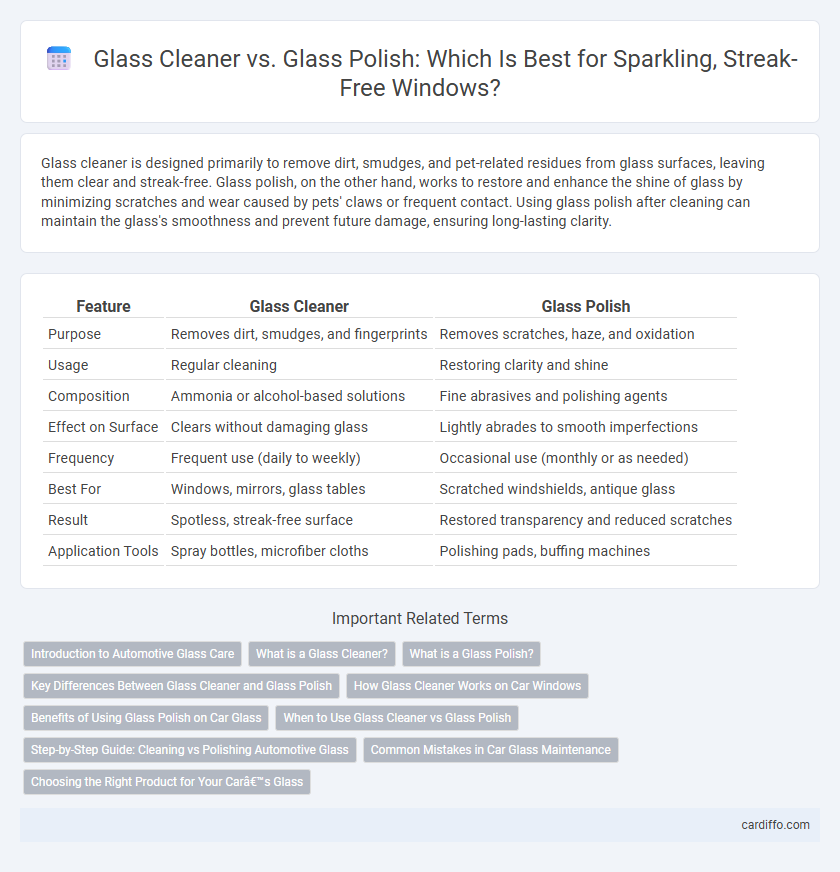Glass cleaner is designed primarily to remove dirt, smudges, and pet-related residues from glass surfaces, leaving them clear and streak-free. Glass polish, on the other hand, works to restore and enhance the shine of glass by minimizing scratches and wear caused by pets' claws or frequent contact. Using glass polish after cleaning can maintain the glass's smoothness and prevent future damage, ensuring long-lasting clarity.
Table of Comparison
| Feature | Glass Cleaner | Glass Polish |
|---|---|---|
| Purpose | Removes dirt, smudges, and fingerprints | Removes scratches, haze, and oxidation |
| Usage | Regular cleaning | Restoring clarity and shine |
| Composition | Ammonia or alcohol-based solutions | Fine abrasives and polishing agents |
| Effect on Surface | Clears without damaging glass | Lightly abrades to smooth imperfections |
| Frequency | Frequent use (daily to weekly) | Occasional use (monthly or as needed) |
| Best For | Windows, mirrors, glass tables | Scratched windshields, antique glass |
| Result | Spotless, streak-free surface | Restored transparency and reduced scratches |
| Application Tools | Spray bottles, microfiber cloths | Polishing pads, buffing machines |
Introduction to Automotive Glass Care
Automotive glass care involves maintaining clarity, safety, and longevity through proper products like glass cleaners and glass polishes. Glass cleaner primarily removes dirt, grime, and smudges from windshields and windows, ensuring clear visibility during driving. Glass polish eliminates minor scratches and imperfections on automotive glass surfaces, restoring a smooth, reflective finish and enhancing overall glass durability.
What is a Glass Cleaner?
A glass cleaner is a cleaning solution specifically formulated to remove dirt, grime, fingerprints, and smudges from glass surfaces, leaving them streak-free and transparent. It typically contains ingredients such as ammonia or alcohol that dissolve oils and residues without damaging the glass. Glass cleaner is designed for routine maintenance, ensuring windows, mirrors, and glass tables remain spotless and clear.
What is a Glass Polish?
A glass polish is a specialized abrasive compound designed to remove surface imperfections such as scratches, stains, and cloudiness from glass surfaces, restoring clarity and shine. Unlike glass cleaner, which primarily removes dirt and smudges, glass polish works by gently smoothing the glass at a microscopic level. It is commonly used in automotive, household, and optical applications to enhance the transparency and aesthetic quality of glass.
Key Differences Between Glass Cleaner and Glass Polish
Glass cleaner primarily removes dirt, fingerprints, and smudges from glass surfaces using ammonia or alcohol-based formulas, leaving a streak-free shine. Glass polish contains mild abrasives designed to remove scratches, haze, and oxidation, restoring clarity and smoothness to glass. The key difference lies in their function: cleaners maintain cleanliness while polishes repair and enhance glass surface quality.
How Glass Cleaner Works on Car Windows
Glass cleaner works on car windows by breaking down and dissolving dirt, grease, and fingerprints using surfactants and solvents that lift contaminants from the glass surface. It evaporates quickly, leaving a streak-free and clear finish that enhances visibility and safety while driving. In contrast, glass polish smooths out minor scratches and imperfections but does not remove smudges or grime like a glass cleaner.
Benefits of Using Glass Polish on Car Glass
Glass polish on car glass enhances clarity by effectively removing fine scratches, oxidation, and water spots that typical glass cleaners cannot address. It creates a smoother surface that improves visibility and reduces glare during night driving, contributing to safer road conditions. Regular use of glass polish also helps maintain the longevity and aesthetic appeal of the windshield and windows by restoring their original shine and transparency.
When to Use Glass Cleaner vs Glass Polish
Glass cleaner is ideal for removing everyday dirt, fingerprints, and smudges from windows and mirrors, providing a streak-free shine quickly and efficiently. Glass polish should be used for deeper restoration tasks, such as eliminating minor scratches, oxidation, or etching, to improve clarity and surface smoothness. Use glass cleaner regularly for maintenance and glass polish periodically for rejuvenating glass surfaces.
Step-by-Step Guide: Cleaning vs Polishing Automotive Glass
Automotive glass cleaning involves removing dirt, grime, and fingerprints using a specialized glass cleaner formulated with surfactants and ammonia-free solvents to prevent streaks and damage. In contrast, glass polishing targets surface imperfections like minor scratches and haze by applying a fine abrasive compound with a microfiber pad, followed by buffing to restore clarity. For optimal results, start with thorough cleaning to ensure the glass is residue-free before proceeding with polishing to enhance visibility and glass longevity.
Common Mistakes in Car Glass Maintenance
Using glass cleaner instead of glass polish on car windows often leaves stubborn water spots and minor scratches untreated, compromising visibility and gloss. Many car owners mistakenly apply abrasive polishes directly to delicate glass surfaces, causing micro-scratches that reduce clarity over time. Proper use of dedicated products tailored for automotive glass maintenance ensures optimal cleanliness without damaging the protective coatings.
Choosing the Right Product for Your Car’s Glass
Glass cleaner effectively removes dirt, fingerprints, and smudges from car windows, providing streak-free clarity essential for safe driving. Glass polish targets deeper imperfections such as minor scratches and water spots, enhancing the glass's smoothness and appearance over time. Selecting the right product depends on your car's glass condition--use glass cleaner for routine maintenance and glass polish for restorative care to maintain optimal visibility and aesthetics.
Glass Cleaner vs Glass Polish Infographic

 cardiffo.com
cardiffo.com